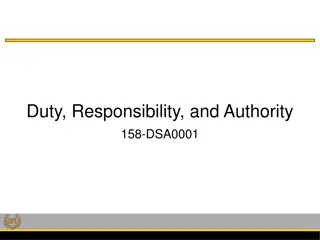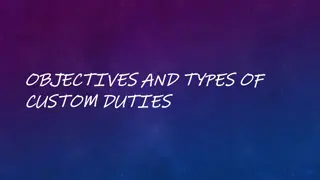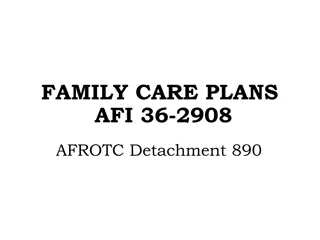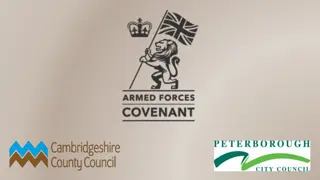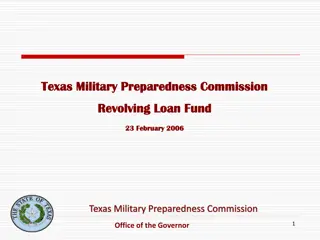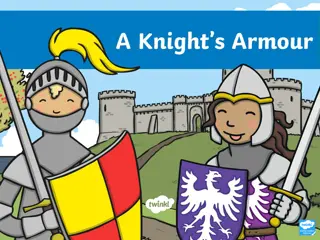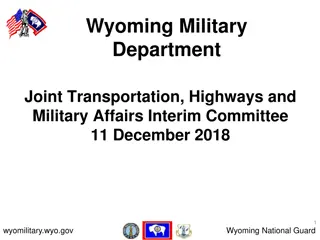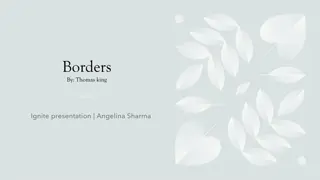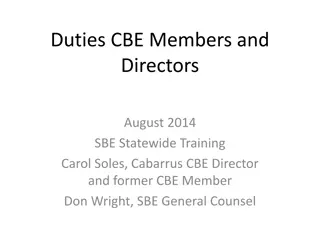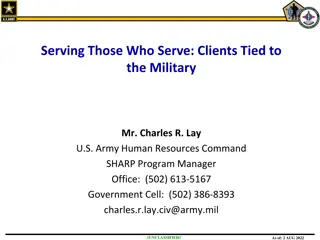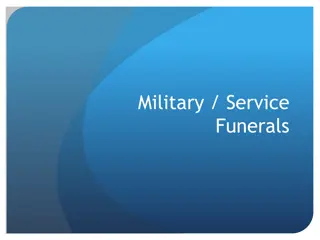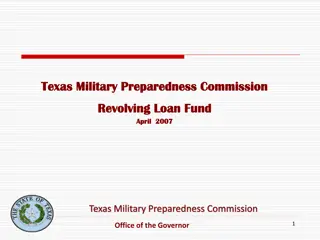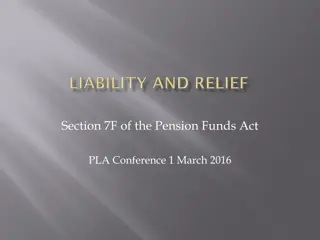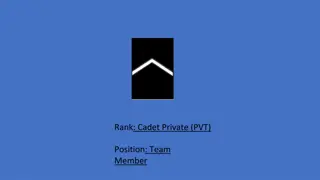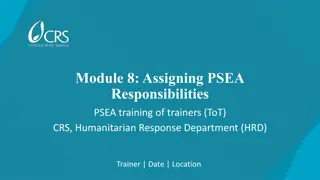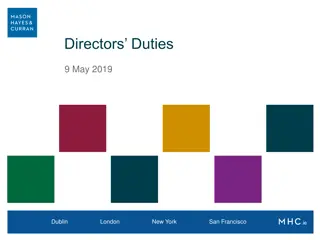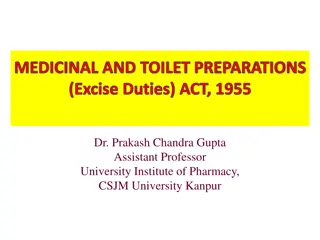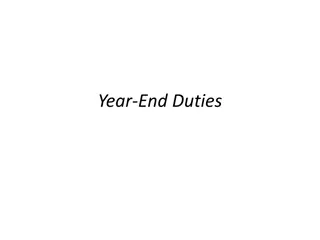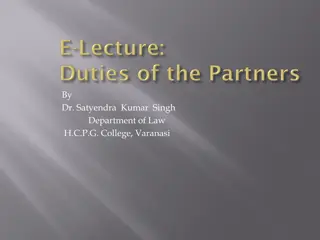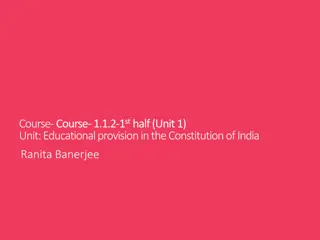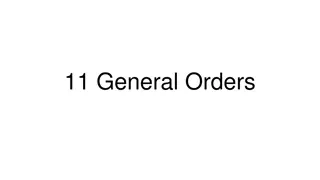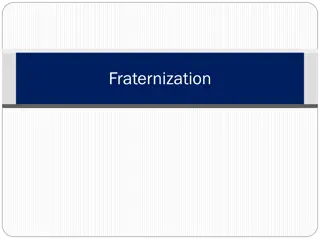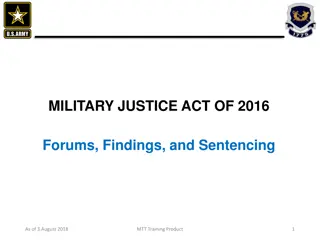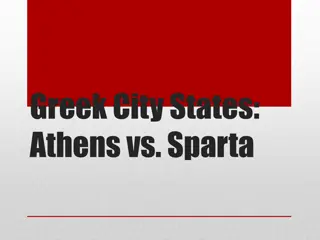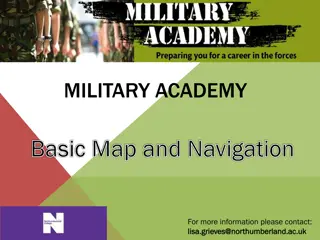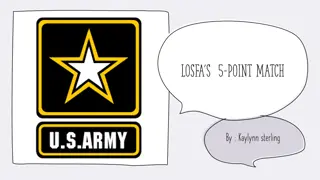Duties and Responsibilities of Guards in Military Operations
Explore the various types of guards including Police Guard, Grand Guard, and Provost Guard along with their specific duties and responsibilities in maintaining order, security, and protection within military camps and operations. Understand the roles of sentinels, pickets, and the importance of countersigns in ensuring effective guard duty execution.
Download Presentation

Please find below an Image/Link to download the presentation.
The content on the website is provided AS IS for your information and personal use only. It may not be sold, licensed, or shared on other websites without obtaining consent from the author. Download presentation by click this link. If you encounter any issues during the download, it is possible that the publisher has removed the file from their server.
E N D
Presentation Transcript
AN OVERVIEW OF GRAND GUARD AND TALES FROM THE PICKET LINE DUTIES OF OFFICERS, NON-COMMISSIONED OFFICERS AND SENTINELS
OVERVIEW Describe the different type of Guards Focus on the overall requirements of a Grand Guard Identify the duties of all participants Clarify the duties associated with each post Sources include: Revised Regulations for the Army of the United States 1861 The 1865 Customs of Service for Officers of the Army (Kautz) Camp and Outpost Duty for Infantry, Butterfield, 1862 Advanced-Guard, Outpost , Mahan, 1861 edition Instructions for Guards and Pickets, Third Edition (Dal Bello) The letters of Elias Peck, 10thConnecticut Volunteer Infantry Regiment
TYPES OF GUARDS Police Guard, aka Garrison, Post or Camp Guard Ensure internal order and security of the camp Protect stores Prevent desertions Keep unauthorized persons from entering the camp Grand Guards and Pickets Protect main body when at rest Posted in the direction of the enemy Cover approaches to the camp The principles of the GRAND GUARD are defined in the Regulations and codified in the Army of the Potomac, General Orders No. 69, Advanced Guards and Marches, issued in February, 1862.
TYPES OF GUARDS Advanced Guards, Rear Guards and Flankers Cover all sides of a command when it is on the march Equivalent of Grand Guard when the command is at rest Provost Guard Provost Marshal appointed by the General-in-Chief or General of Division to take charge of prisoners, arrest stragglers and other transgressors, supervise the passes of military personnel, sign passes of civilians, deal with civilian complaints about the men s actions, and take charge of scouts General s Guards Escort general officers and protects the camp and stores at headquarters
DEFINITIONS GUARD Refers to the body of soldiers assigned to that duty; guards are relieved every 24 hours SENTINEL An individual soldier assigned to a guard; relieved every 2 hours PICKET A sentinel, only referred as such when on GRAND GUARD duty. COUNTERSIGN A password given only to those permitted to visit and pass the line of sentries at night (officers and NCOs on duty), and to members of the GUARD. Not typically given to interior sentinels.
PURPOSE AND COMPONENTS OF THE GRAND GUARD When in the presence of the enemy, and on campaign, in addition to CAMP GUARDS, there are GRAND GUARDS, consisting outposts, pickets, and reconnaissances. THE PURPOSE OF THE GRAND GUARD IS TO WATCH FOR THE ENEMY. GRAND GUARDS are detailed from each Brigade in a Division to protect the main body when it is at rest. GRAND GUARDS are deployed in the morning in conjunction with the posting of the CAMP GUARD. The GRAND GUARD of a Brigade is commanded by a Captain under the supervision of the Field Officer of the Day, typically a Major or Lieutenant-Colonel. A senior captain may also serve as Field Officer of the Day. The BRIGADE GUARDS of each Division are under the supervision of a General Officer of the Day, typically a Colonel, who receives orders directly from the Division commander.
PURPOSE AND COMPONENTS OF THE GRAND GUARD GRAND GUARDS are posted in the direction of the enemy to cover the approaches to the camp. They are placed closed enough to the Brigade camp to quickly report to the main body of an enemy advance, yet far enough away to delay the enemy and give the main body time to form up. Each GUARD consists of: A RESERVE, occupying a commanding position stationed between a mile and a mile-and-a-half from the main body. A line of two or three SUPPORTS from which sentinels are furnished, stationed a mile in front of the RESERVE. SUPPORTS should be placed so that they easily communicate with each other and the RESERVE. A line of SENTINELS, called PICKETS, positioned 200 yards in front of the SUPPORTS. PICKETS shall be posted in groups of three. The RESERVE shall be of sufficient strength to check the advance of the enemy, thus affording the main body of the army ample time to form and prepare for attack. The RESERVE shall give a rallying point for the PICKETS and SUPPORTS. At least one commissioned officer and one-third of the men of the RESERVE must be on alert at all times.
PURPOSE AND COMPONENTS OF THE GRAND GUARD
PURPOSE AND COMPONENTS OF THE GRAND GUARD
PURPOSE AND COMPONENTS OF THE GRAND GUARD A line of SENTINELS shall be provided by the RESERVE to communicate with the SUPPORTS and the Brigade headquarters. A detachment of Cavalry and Field Artillery may be attached to the RESERVE. The GUARD may also include OUTPOSTS which are isolated advanced posts of greater or lesser strength. The RESERVE shall also send out patrols between the lines and a short distance to the front of the line of PICKETS to examine areas not fully in view of the PICKETS. In general, the GUARD should consist of 10% of the effective strength of the main body. The RESERVE should comprise two- thirds of the entire GUARD, with the other third assigned to the SUPPORTS.
PURPOSE AND COMPONENTS OF THE GRAND GUARD
GENERAL INSTRUCTIONS FOR THE RESERVES AND SUPPORTS The GUARD is marched to its post by the FOoD, guided by a Brigade staff officer who knows where the Brigade commander wants to place the posts. The GUARD is posted to defend a pass or natural approach, or on centrally located high ground. The GUARD is to be situated so as to conceal its strength while observing its front. GRAND GUARDS shall: Inform the nearest posts and the FOoD, or the General of the Brigade, of the march and movements of the enemy, and of the attacks they receive or fear; Examine every person passing near the post, particularly those coming from without;
GENERAL INSTRUCTIONS FOR THE RESERVES AND SUPPORTS GRAND GUARDS shall: Arrest suspicious persons, and all soldiers and camp-followers trying to pass without permission, and to shoot all persons deserting to the enemy; Send to the General, unless otherwise directed, all country people may come into the lines. The RESERVE may also send out patrols between the lines and a short distance to the front of the line of PICKETS to examine such portions of the country not fully in view of the PICKETS. At night men are sent forward to guard key approaches and shall move about to better observe and for their safety. All GUARDS (members of the SUPPORTS and RESERVE) shall take arms at the approach of any party at night.
GENERAL INSTRUCTIONS FOR THE RESERVES AND SUPPORTS Each SUPPORT will include one Officer (Lieutenant), one Sergeant, and three Corporals. One Corporal will be responsible for each relief. The commander of each SUPPORT should go out with the first relief to post the PICKETS and see that they are connected with the PICKETS on either side of his command. He must know the best routes of retreat and ways to impede the enemy. SUPPORTS will hold themselves in readiness to receive PICKETS and repel an attack, retiring in good order upon the RESERVE when unable any longer to hold their ground One relief of the SUPPORTS are allowed to sleep and one relief must constantly be on alert. No fires are allowed along the line of the SUPPORTS or outside the line of RESERVES. SUPPORTS shall be relieved every six hours and the PICKETS every two hours. To reduce the number of rounds (visits of the OOoD or NCO of the Guards to the sentinels), and to keep the men alert, PICKETS may be relieved hourly.
GENERAL INSTRUCTIONS FOR THE RESERVES AND SUPPORTS The RESERVE shall include the Commander of the Guard, two Officers, two Sergeants, and six Corporals. At night, half of the men of the RESERVE are under arms, the rest with arms. Fires may be built on the line of RESERVES and must be screened from the view in the front by nature of the ground. A RESERVE may not be required when the main body is under arms, or when the lines are close as when the armies are entrenched. The rebels are about 300 yards ahead. (E. Peck) Last night we were sent out here on picket. The rebel pickets are only 100 feet from us & we have been looking at one another this morning. (E. Peck)
GENERAL INSTRUCTIONS FOR THE PICKETS PICKETS should be posted: Where they can see the furthest. Where they are out of site of the enemy. Where they are in communication with each other and their SUPPORTS. Compliments are dispensed with on PICKET duty. During the day the line of SENTINELS should pass over the highest points, and post in front of such ground as covered by timber or brushwood. At night they move to low ground just within the front of any timber or brush so they can see silhouettes against the sky, and so that they themselves are not seen. PICKETS shall be posted in groups of three posted no more than 150 yards apart. In each group of three, the SENTINELS take posts 50 yards apart. The center SENTINEL will be stationery and the two outer SENTINELS shall continually patrol to meet the outer SENTINELS of adjacent groups.
GENERAL INSTRUCTIONS FOR THE PICKETS PICKETS should: Be well instructed on his duties, primarily watching a certain area to his front for enemy movements Keep unauthorized persons from passing the line. Always be ready to fire. Fire on all persons deserting to the enemy. That night a substitute belonging to our reg t attempted to desert from his post on picket and go over to the rebels, but the vidette next to him shot him dead They knew he was going to desert before and had men outside of the videttes watching for him. The ball went clean through him. The man that shot him was another substitute and he was a rebel deserter. He deserted from the rebels and came into our lines and went north and enlisted as a substitute. He has been promoted to a sergeant and will get a 30 day furlough and $30. (E. Peck)
GENERAL INSTRUCTIONS FOR THE PICKETS PICKETS should: Be sure the enemy is advancing or intending to do so before firing. Discharging a weapon should always mean an attack. We have got orders not to fire on the rebels unless they advance. If we see them moving around and they fire on us we are ordered not to fire back. (E. Peck) The practice of firing upon opposing PICKETS is barbarous; and retaliation is scarcely a sufficient excuse. Colonel Otis went out with a flag of truce the other day. He saw a rebel colonel and spoke to him about the picket shooting. The rebel colonel said it did not do any good. Otis told him our men would not fire on his if they did not commence it. They made an agreement that the pickets were not to fire on one another unless in case of advance. (E. Peck)
GENERAL INSTRUCTIONS FOR THE PICKETS PICKETS should: The practice of firing upon opposing PICKETS is barbarous; and retaliation is scarcely a sufficient excuse. At daylight yesterday we was sent from the breastworks out as a reserve for the pickets in front of our brigade. We lay in the old rebel rifle pits. The 17thME reg t was on the outposts. There was firing all along the lines between the pickets. Our outposts were but a short distance from the rebel breastworks and they threw shells into them every few minutes. (E. Peck) Fire even though all defense of his post be useless, as the safety of the many depend on it.
GENERAL INSTRUCTIONS FOR THE PICKETS PICKETS should: Fire before withdrawing if the enemy suddenly advances in order to warn the other PICKETS and SUPPORTS. Act as a line of skirmishers when firing. When forced to withdraw they shall move to the flanks of the SUPPORT. The rebels made a charge on our pickets in the next brigade to the left of us. They drove our men back at first and got in our rifle pits The outposts of our brigade fell back in the rifle pits that our reg t was in on reserve and as soon as the rebels showed themselves both reg t of us rose up and gave them a volley. They left in a hurry and did not show themselves in front of our brigade again. After they left in front of our brigade our company was sent out to reinforce the pickets in our brigade to the left of us. (E. Peck)
GENERAL INSTRUCTIONS FOR THE PICKETS PICKETS should: Challenge all parties approaching his line. At night he shall order all parties to HALT . If the party halts, the PICKETS calls Who goes there? If the party answers Friend , the PICKET will state Advance, friend, with the countersign. If the party answers Friends . The PICKET will state Halt, friends, Advance, one, with countersign . If the party does not halt, if they advance more than one person, or do not give the correct countersign, the PICKET fires and falls back to the SUPPORT.
GENERAL INSTRUCTIONS FOR THE PICKETS PICKETS shall not communicate with the enemy unless ordered to by an officer to gain information or an other objective. We were on picket yesterday. The Lt. Colonel of the 11thMass reg t. who was in command of the picket line yesterday went outside our picket line The first thing he knew he was close up to a rebel picket post so close that had he undertook to run back the rebels would have shot him. A lucky thought struck him and he pulled out a newspaper and told the picket that he came out to exchange papers with him and he thought the post was somewhere about here but did not think it was so close. The rebel took his paper and gave him one of theirs and he came back very tickled to think he was not taken prisoner If the rebel was smart he would have known that no Lt. Colonel would go out to exchange newspapers with them. Privates often go out there to exchange papers with them but not officers. (E. Peck)
GENERAL INSTRUCTIONS FOR THE PICKETS PICKETS shall not communicate with the enemy unless ordered to by an officer to gain information or an other objective. I was trading with a rebel Lieutenant The rebel rifle pits were about 250 feet from my post Just before night the whole of the rebel pickets stopped their firing and came rushing down towards us shaking the latest newspapers from Richmond and our men who a few minutes before were firing at one at one another were now talking as good friends and trading. They wanted to know about the Chicago convention (E. Peck) Bearers of flags of truce are not allowed to pass the line of outer PICKETS. They shall be made to face away from the lines. If they must pass between the lines they must be blindfolded and escorted by an NCO.
GENERAL INSTRUCTIONS FOR THE PICKETS Deserters coming into the lines are to be disarmed and let in a few at a time if they appear at night. A rebel deserter came in today & said they tended to have charged on our main works here yesterday but they could not even drive in our pickets. (E. Peck) Parties leaving the lines must prove they are authorized to do so. A system of silent signals should be established to warm the SUPPORTS. Courage and common sense are the primary requisites for a PICKET (Kautz)



